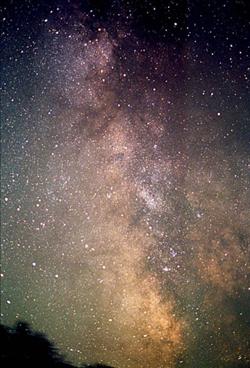A collision between another galaxy and our own 5 billion years ago may have spawned the stars in the outer Milky Way, say astronomers at the University of North Carolina, Chapel Hill. The collision triggered the birth of stars with unique elemental abundances.
David Yong, Bruce Carney, and Maria Luísa Teixera de Almeida discovered the unusual chemical signature when they observed four open star clusters. The star clusters — Berkeley 20 and NGC 2141 in Orion, Berkeley 29 in Gemini, and Berkeley 31 in Monoceros — all reside in the Milky Way’s outer disk, 38,000 to 73,000 light-years from the galactic center. The Sun lies in the disk, too, but only 27,000 light-years from the center.
However, Yong and his colleagues found that beyond about 40,000 light-years from the galaxy’s center, the disk’s iron abundance stops dropping. Instead, the clusters’ iron content hits a “basement” at about 30 percent of the Sun’s and then holds steady at greater distances.
The astronomers also find the three outermost star clusters have high levels of oxygen and magnesium relative to iron. Oxygen and magnesium originate in short-lived, high-mass stars such as Rigel and Antares, which eject these elements into the galaxy when they explode as supernovae.
The three outermost clusters are about as old as the Sun. This age, together with their iron, oxygen, and magnesium abundances, makes them unique: No known stellar population in the Milky Way has all these properties, and neither do the dwarf galaxies that revolve around it. Thus, Yong and his colleagues suggest the star clusters may owe their existence to an intruder galaxy — one that merged with the Milky Way billions of years ago.
They imagine this intruder skirted the Milky Way’s disk in the same direction it spins. As the two galaxies gradually merged, the intruder spilled its stars and gas into the outer Milky Way. Both by stirring up the gas in the outer disk and by smashing its own gas into the Milky Way’s, the intruder stimulated a burst of star formation in our galaxy’s disk that created at least three of the clusters the astronomers observed.
This gas was slightly poor in iron, explaining the moderately low iron content of the clusters. As short-lived massive stars exploded, they distributed oxygen and magnesium but little iron, which explains why the clusters the astronomers observed show high oxygen-to-iron and magnesium-to-iron ratios.
Unlike oxygen and magnesium, iron comes mostly from white dwarfs, which take much longer to form and explode only under special circumstances. But because star formation occurred in a burst, triggered by the intruder galaxy, it didn’t last long — it was over before white dwarfs could add iron to the gas that was creating the new stars.
“I think it’s a very important contribution to the field,” says Eileen Friel of the National Science Foundation and an expert on old open star clusters. “Whether the clusters were formed during the merger event or whether they were part of the galaxy that might have merged with the Milky Way is still an open question. But using chemical tagging to sort through very complex stellar populations offers enormous potential, and it’s really neat to see it being used in the outer disk, in areas that we haven’t been able to probe yet.”
If a galactic collision did produce the Milky Way’s outer disk, it likely happened about 5 billion years ago — shortly before the Sun and Earth were born. That’s because the three outermost star clusters Yong’s team studied are 4.3 to 5.3 billion years old.
The new work dovetails with recent findings about the fringes of the Milky Way and Andromeda. In 2003, other astronomers discovered a small galaxy in Canis Major that’s colliding with the Milky Way’s outer disk. And just last week, astronomers reported an enormous disk of stars on the outskirts of the Andromeda Galaxy. The newfound disk likely represents the wreckage of smaller galaxies.
Yong and his colleagues will publish their work in a future issue of The Astronomical Journal..










